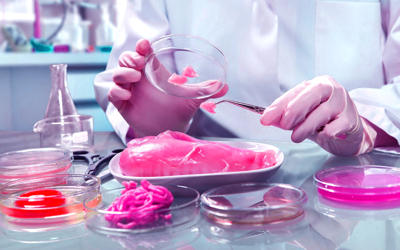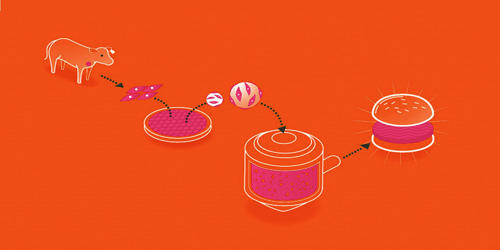Cellular agriculture is the production of agricultural products from cell cultures. It is just a method of making foods that conventionally come from animals, but without those animals. It focuses on the production of agriculture products from cell cultures using a combination of biotechnology, tissue engineering, molecular biology, and synthetic biology to create and design new methods of producing proteins, fats, and tissues that would otherwise come from traditional agriculture. It’s based on looking at the biological processes that happen on a cellular level when, for example, milk is made by a cow, or an egg is made by a hen – and then replicating that process.
There are two kinds of agricultural products: acellular products and cellular products. Acellular products are made of organic molecules like proteins and fats and contain no cellular or living material. Cellular products are made of living or once-living cells. An important benefit of directly harnessing the cellular processes for producing animal food is that it is not necessary to raise and feed a whole animal that lives, breathes, and walks around – microorganisms are much more efficient. In comparison to conventional livestock agriculture, cellular agriculture provides an alternative that is more environmentally friendly and, as a result, more sustainable.

Fig – Cellular Agriculture: The Future of Food
Most of the industry is focused on animal products such as meat, milk, and eggs, produced in cell culture rather than raising and slaughtering farmed livestock. The most well known cellular agriculture concept is cultured meat. For meat, this can mean growing muscle cells in tanks to produce clean meat, while for milk, this can mean making milk proteins in an organism like yeast by using recombinant DNA technology.
Fundamental changes in agriculture and food production are inevitable. Providing food for an increasing population will be a great challenge that coincides with the pressure to reduce the negative environmental impacts of conventional agriculture. Cultured meat is a promising technology for animal-based proteins but still needs further development. While the present livestock agricultural system has been sufficient in producing enough to meet the current demand for products like meat, the present system will not suffice to meet future demands due to increased population growth. By providing the alternative, cellular agriculture has the potential of helping reduce global greenhouse gas emissions as well as promote more responsible uses of natural resources.
















